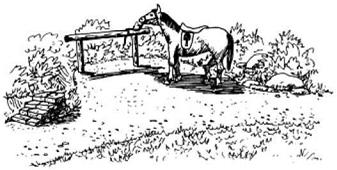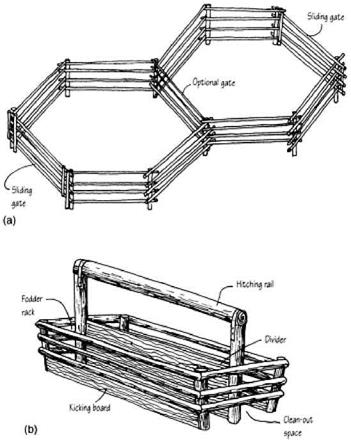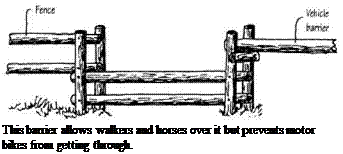In many areas people enjoy exploring the outdoors on horseback. For some this will consist of riding from home, a livery stable or paddock into a woodland, across a common or along a bridleway. Some might take their horse to a particular destination by car and trailer, ride some trails and return home in a day. Others might go on a guided pony trek as part of a residential holiday or from a dude ranch. Finally, some will plan to ride a trail over several days, camping at places along the route where fodder and corral facilities are located. Whatever the way a trail is ridden, the route, the surface and the facilities such as loading areas, hitching rails or corrals need to be carefully considered in their planning and design.
The trail may be an established route such as a British bridleway, where landowners are legally obliged to maintain the route in an open condition. It may be used by hikers as well as horses, which may pose problems when the way is narrow and heavily used. It is always preferable in busy areas to segregate trails, with special ones established for horses only, while keeping hiking routes horse free.
Rough and steep horse trails are acceptable in places if it is expected that experienced riders will use them. Pony trekking or dude ranch operators may expect inexperienced or novice riders, and so they will want a range of trails from easy ones to those of a rougher nature. Riding for the disabled is a popular activity and requires extremely gentle routes.
The trail route should be laid out in a similar way as for hiking, when viewing the scenery is one of the purposes as well as exercise. The distances can be longer, as the horse is usually a quicker means of transport and the views gained from the higher position on the back of a horse are slightly more extensive than those on foot.
In areas of firm, freely drained mineral soils with rock, sand or gravel, the surfacing of the trail may need little or no attention. Sandy soils make excellent surfaces with a low risk of injury, so that stretches for a canter of gallop can be provided. However, poorly draining clay soils can churn up, and when hoof prints are deep they can fill with water, become frozen and the surface turn into a quagmire. In such circumstances it may be necessary to close the trail during very wet weather, restrict the overall amount of use, have alternative routes so that damaged ones can be repaired or given time to recover, or surface the trail with stronger materials to prevent damage.
If surfacing is used, the trail should be constructed in a similar manner to a footpath. The width should allow two horses to pass with ease. Trees should be kept back from edges so that riders’ legs are at less risk of being injured as they pass. Low branches should be removed along the route. Additional surfacing can also be provided for a softer ride, to reduce the wear and tear on horses’ shoes and to deaden the noise. Shredded bark or wood chips are excellent for this. Sand can also be used but is more likely to be washed off during rain on steeper stretches.
Water crossings can be forded in more circumstances than for hikers, thus reducing the need for bridges. Where bridges are needed, wider decking, solid planking with narrower gaps and possibly bark surfacing should be used. The handrails should be higher to prevent riders from falling over. Some horses do not like crossing bridges, so softer surfaces may help by reducing the noise and the risk of possible injury if a horse shies. However, it is often prudent to lead a horse across a bridge.
At points where the rider may wish to stop to look at views, eat lunch or observe wildlife, hitching posts or rails are needed. A sturdy timber structure will suffice, but it must be securely fastened to withstand jerking movements by the tethered horse. A lay-by or flat open area away from the trail should be found so that the hitched horse cannot interfere with other riders passing by. If a group are out riding then more rails will be needed. Steps for remounting horses might also be provided for the convenience of some riders. Such steps should use the type of construction
 |
A trail for horses is provided with a hitching rail of simple but appropriate design and a set of mounting steps at places where riders may want to dismount to look at a view or have a picnic.
 |
An unloading ramp of two different heights allows for different trailers or vans to back up to it. Hitching rails are provided to tether the unloaded horses. Timber construction is used, with earth and hardcore infill behind the ramp retaining wall. Based on an example from the Alberta Forest Service.
suggested earlier in this section.
Where horses are brought to the area in a horsebox or trailer, special parking and unloading places should be provided so that the horses are kept out of the way of other cars and pedestrians. Hitching areas or a corral will reduce the risk of horses getting loose and causing problems elsewhere.
If camping takes place along a long-distance horse trail, overnight accommodation will be needed for the horse as well as for the rider. If a field, stable or paddock is not available, a corral is usually suitable and can be of post and rail or pole construction in a typical farm or ranch style. Corrals can be built for several horses or for single animals. Horse stalls can also be used instead of corrals. These are like open – air stables, where the horse is tied in and provided with a manger. Water can be supplied from a spring for tap and fed into a trough made from galvanized steel. Fodder can be carried in a nosebag (oats or nuts), foraged around the area or provided at the campground as hay, nuts or oats. Hence storage and fodder supply has also to be provided, along with hay racks, mangers and water troughs. All structures can be made out of rough sawn or round timber, which should be untreated to avoid poisoning the horses if they lick or chew it. All bolts or nails must be recessed, cut off or otherwise hidden. Sharp corners or angles should be removed from post ends and sawn planks to prevent injury to the horses. Horses can be hobbled or tied to a long rope secured to a post, but this can be risky.
The location of horse facilities should be downwind of the camping area to reduce smells, but should be sufficiently distant so that smoke from campfires does not affect the horses. The facilities should also be placed away from any streams to minimize the risk of pollution from horse droppings and urine. The soil on which they are constructed should be suitable for horse use, as described earlier.
 |
(a) This design for a horse corral is in a traditional style with all pole ends outside the fence and an absence of narrow corners to reduce the risk of injury to the horses. Several corrals can be linked together to increase capacity in busy areas. Based on an example from the US Forest Service. (b) A feed rack to be built where horses stay overnight. The hitching rail is incorporated into it.
Horse trails, like other trails, may have to pass through fences or other barriers. Traditionally, gates have been provided that can be opened from horseback by hand or by using a whip or crop handle. Selfclosing devices such as rising hinges and spring – loaded catches are fitted, as it is easier to lean forward from a horse to open a gate than it is to lean back and close it. If the main purpose of the barrier is to keep motorcycles out, a gate is inadequate. Instead, spaced horizontal logs set on posts about 1m (3ft) above ground level allow horses to step over them, but are too high for motorcycles to be lifted or wheeled over.
All-terrain cycle trails
One of the growth areas of outdoors recreation is that of all-terrain cycles or mountain bikes. These can go almost anywhere, can attain quite high speeds on downhill stretches, and can cause severe wear and tear, especially on soft ground. In general, where the trail system is well used by walkers, mountain bikes should be kept separate in order to avoid accidents. Codes of conduct for cyclists should be encouraged. As for hiking and horseriding, the cycle route should be chosen with the overall experience in mind, including physically challenging sections, interesting features and views.
 |
Routes should be chosen to avoid soils that are easily eroded, and should be aligned where possible to prevent washout during rainy periods. Some
surfacing may be needed in soft or wet places, where these cannot be avoided. Cyclists might also be encouraged to use forest or park roads for some stretches. This will reduce wear and tear elsewhere.
Routes should be waymarked where there may be doubt about the direction, so that cyclists do not stray into more sensitive areas. However, in many places, especially if the use is light and the terrain robust, unrestricted access to roam around might be permitted.
|
Waymarking should be provided to ensure that bikes follow any special trails. |
In cases where the trail surfacing has collapsed, remedial action should be taken as quickly as possible. Routes may have to be diverted, the surface reinforced and drainage laid.
Cyclists can usually use the same water crossings as walkers, carrying their cycles if need be. This reduces the number of bridges and fords that are needed. If cyclists and hikers or horses have to cross or share a section of route, the layout should allow plenty of passing room, and the code of conduct should explain who gives way to whom. Signs should give warning of the section, especially crossing of one path by another, and the trail layout should ensure good visibility, a crunchy surface to warn of cyclists’ approach, and possibly barriers to keep users separate in unavoidably narrow sections.
Bikes can also be carried over stiles in most instances. Where there are kissing gates it is possible to insert a special slot in the enclosing fence that will allow a cycle to be passed through but not an animal or motorcycle (see diagram).
As cycles are valuable and easily stolen, racks that can be locked should be provided for them at car parks or other risky places. A design suitable for the outdoors consists of a log with slots cut out of it. Each slot has a strong eyelet screwed in next to it. The cycle wheel or frame is placed in the slot, and the cyclist can lock it to the eyelet using their own lock.




